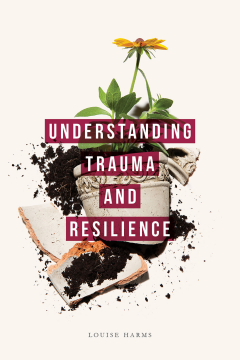
Additional Information
Book Details
Abstract
People's lives can be turned upside down in a moment. Whether it's a car accident, a terminal illness or the death of a family member, practitioners working across the people professions frequently find themselves working with service users, patients and clients who are survivors of trauma. How people deal with these life changes differs from one person to the next and there is no blanket explanation.
Understanding Trauma and Resilience addresses the multifaceted nature of trauma by bringing together the many theoretical perspectives that explain how people cope with traumatic life experiences. Ranging between attachment, person-centred and anti-oppressive approaches, each chapter takes a contemporary approach and provides students and practitioners with an in-depth analysis of the histories, core assumptions and critiques of each perspective. Rich in theory and practice, case examples and case scenarios run throughout to demonstrate the integration of each approach in to real-life practice and to illustrate the different responses to trauma.
Whether you are a student or practitioner of counselling, social work or mental health, this book provides the foundations for understanding people's responses and resilience against traumatic life experiences.
Louise Harms is Deputy Head of Social Work and Director of Teaching and Learning, Melbourne School of Social Sciences, University of Melbourne, Australia. Her background in psychology, trauma counselling and psychotherapy have informed, and been informed by, her research interests in grief and trauma impacts on individuals and families. She has written widely in the area of trauma, and is the author of Working with people: Communication skills for reflective practice.
Table of Contents
| Section Title | Page | Action | Price |
|---|---|---|---|
| Cover | Cove | ||
| Contents | v | ||
| List of Figures, Tables and Boxes | viii | ||
| Preface | ix | ||
| Acknowledgements | xi | ||
| Introduction | 1 | ||
| The structure of this book | 2 | ||
| Chapter 1 Theorising Trauma and Resilience | 4 | ||
| Introduction | 4 | ||
| Defining trauma | 4 | ||
| Defining recovery and resilience | 8 | ||
| Theorising trauma and resilience responses: Introducing a multidimensional approach | 13 | ||
| Implications for practice and research | 22 | ||
| Practitioners’ and researchers’ critical reflections | 24 | ||
| Conclusion | 27 | ||
| Chapter 2 Psychodynamic Approaches: Reintegratingthe Self | 28 | ||
| Introduction | 28 | ||
| Psychodynamic explanations of the developing self and resilience | 29 | ||
| Psychodynamic explanations of trauma responses | 30 | ||
| Implications for practice | 39 | ||
| Critically reflecting on psychodynamic approaches | 45 | ||
| Conclusion | 45 | ||
| Chapter 3 Attachment Approaches: Regulating Self andRelationships | 46 | ||
| Introduction | 46 | ||
| Attachment explanations of resilience | 46 | ||
| Attachment explanations of trauma responses | 54 | ||
| Implications for practice | 59 | ||
| Critically reflecting on attachment approaches | 64 | ||
| Conclusion | 65 | ||
| Chapter 4 Symptom Approaches: Reducing PTSD | 66 | ||
| Introduction | 66 | ||
| Post-traumatic stress disorder as a trauma response | 66 | ||
| Resilience and recovery from post-traumatic stress | 78 | ||
| Implications for practice | 78 | ||
| Critically reflecting on symptom approaches | 85 | ||
| Conclusion | 88 | ||
| Chapter 5 Person-Centred Approaches: Recreating Congruence | 89 | ||
| Introduction | 89 | ||
| Person-centred approaches to resilience and recovery | 89 | ||
| Person-centred approaches to trauma | 93 | ||
| Implications for practice | 99 | ||
| Critically reflecting on person-centred approaches | 103 | ||
| Conclusion | 105 | ||
| Chapter 6 Narrative Approaches: Re-authoring for Meaning and Coherence | 107 | ||
| Introduction | 107 | ||
| Narrative understandings of resilience | 108 | ||
| Narrative understandings of trauma | 110 | ||
| Implications for practice | 115 | ||
| Critically reflecting on narrative approaches | 121 | ||
| Conclusion | 122 | ||
| Chapter 7 Social-Ecological Approaches: Rebuilding and Sustaining Systems | 123 | ||
| Introduction | 123 | ||
| Social-ecological understandings of resilience | 123 | ||
| Social-ecological understandings of trauma | 133 | ||
| Implications for practice | 138 | ||
| Critically reflecting on social-ecological approaches | 141 | ||
| Conclusion | 142 | ||
| Chapter 8 Anti-oppressive Approaches: Recognising Rights and Redressing Oppression | 144 | ||
| Introduction | 144 | ||
| Anti-oppressive approaches to resilience | 144 | ||
| Anti-oppressive approaches to trauma | 149 | ||
| Implications for practice | 159 | ||
| Critically reflecting on anti-oppressive approaches | 163 | ||
| Conclusion | 164 | ||
| Chapter 9 Promoting Resilience and Recovery: An Integrative Approach | 165 | ||
| Introduction | 165 | ||
| Drawing together understandings of trauma and resilience | 165 | ||
| Thinking dimensionally about trauma and resilience | 168 | ||
| Thinking and working in multidimensional ways | 174 | ||
| Conclusion | 176 | ||
| References | 177 | ||
| Index | 203 |
